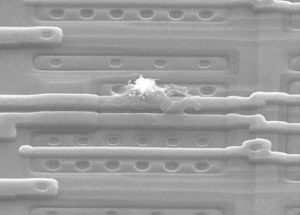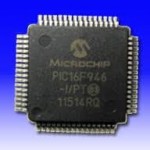Read MCU PIC18F8722 Flash
Read MCU PIC18F8722 Flash program and eeprom data out from the memory and clone the firmware into other blank Microcontroller which will provide the same functions;

Read MCU PIC18F8722 Flash
The PIC18F8722 family of devices includes a feature that allows the device clock source to be switched from the main oscillator to an alternate clock source. These devices also offer two alternate clock sources. When an alternate clock source is enabled, the various power-managed operating modes are available.
Essentially, there are three clock sources for these devices:
· Primary oscillators
· Secondary oscillators
· Internal oscillator block
The primary oscillators include the External Crystal and Resonator modes, the External RC modes, the External Clock modes and the internal oscillator block. The particular mode is defined by the FOSC<3:0> Configuration bits. The details of these modes are covered earlier in this chapter.
The secondary oscillators are those external sources not connected to the OSC1 or OSC2 pins. These sources may continue to operate even after the controller is placed in a power-managed mode. The PIC18F8722 family of devices offers the Timer1 oscillator as a secondary oscillator. This oscillator, in all power-managed modes, is often the time base for functions such as a real-time clock.
Most often, a 32.768 kHz watch crystal is connected between the RC0/T1OSO/T13CKI and RC1/T1OSI pins. Like the LP mode oscillator circuit, loading capacitors are also connected from each pin to ground.
In addition to being a primary clock source, the internal oscillator block is available as a power-managed mode clock source. The INTRC source is also used as the clock source for several special features, such as the WDT and Fail-Safe Clock Monitor. The clock sources for the PIC18F8722 family of devices are shown in Figure 2-11. See Section 25.0 “Special Features of the CPU” for Configuration register details. The OSCCON register (Register 2-2) controls several aspects of the device clock’s operation, both in full power operation and in power-managed modes.
The System Clock Select bits, SCS<1:0>, select the clock source. The available clock sources are the primary clock (defined by the FOSC<3:0> Configuration bits), the secondary clock (Timer1 oscillator) and the internal oscillator block. The clock source changes immediately after either of the SCS<1:0> bits are changed, following a brief clock transition interval.
The SCS bits are reset on all forms of Reset. The Internal Oscillator Frequency Select bits (IRCF<2:0>) select the frequency output of the internal oscillator block to drive the device clock. The choices are the INTRC source (31 kHz), the INTOSC source (8 MHz) or one of the frequencies derived from the INTOSC postscaler (31.25 kHz to 4 MHz). If the internal oscillator block is supplying the device clock, changing the states of these bits will have an immediate change on the internal oscillator’s output.
On device Resets, the default output frequency of the internal oscillator block is set at 1 MHz. When a nominal output frequency of 31 kHz is selected (IRCF<2:0> = 000), users may choose which internal oscillator acts as the source. This is done with the INTSRC bit in the OSCTUNE register (OSCTUNE<7>).
Setting this bit selects INTOSC as a 31.25 kHz clock source derived from the INTOSC postscaler. Clearing INTSRC selects INTRC (nominally 31 kHz) as the clock source and disables the INTOSC to reduce current consumption. This option allows users to select the tunable and more precise INTOSC as a clock source, while maintaining power savings with a very low clock speed.
Additionally, the INTOSC source will already be stable should a switch to a higher frequency be needed quickly. Regardless of the setting of INTSRC, INTRC always remains the clock source for features such as the Watchdog Timer and the Fail-Safe Clock Monitor. The OSTS, IOFS and T1RUN bits indicate which clock source is currently providing the device clock. The OSTS bit indicates that the Oscillator Start-up Timer and PLL Start-up Timer (if enabled) have timed out and The PIC18F8722 family of devices contains circuitry to prevent clock “glitches” when switching between clock sources. A short pause in the device clock occurs during the clock switch.
The length of this pause is the sum of two cycles of the old clock source and three to four cycles of the new clock source. This formula assumes that the new clock source is stable. Clock transitions are discussed in greater detail in Section 3.1.2 “Entering Power-Managed Modes”.
Tags: read mcu locked archive,read mcu locked code,read mcu locked content,read mcu locked data,read mcu locked eeprom,read mcu locked file,read mcu locked firmware,read mcu locked information,read mcu locked memory,read mcu locked program


